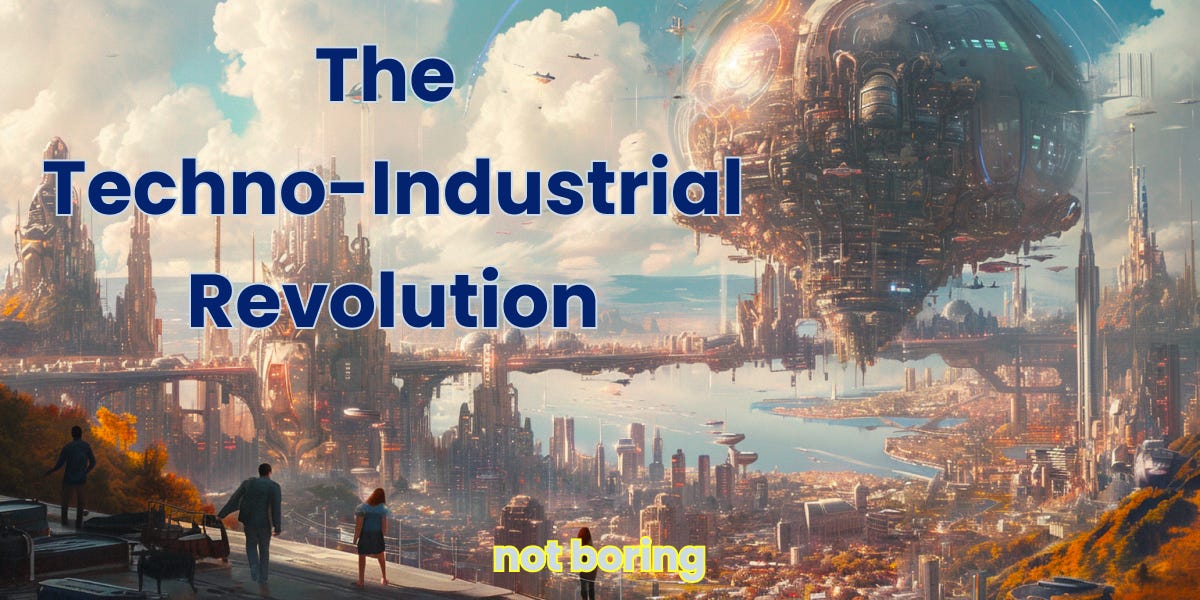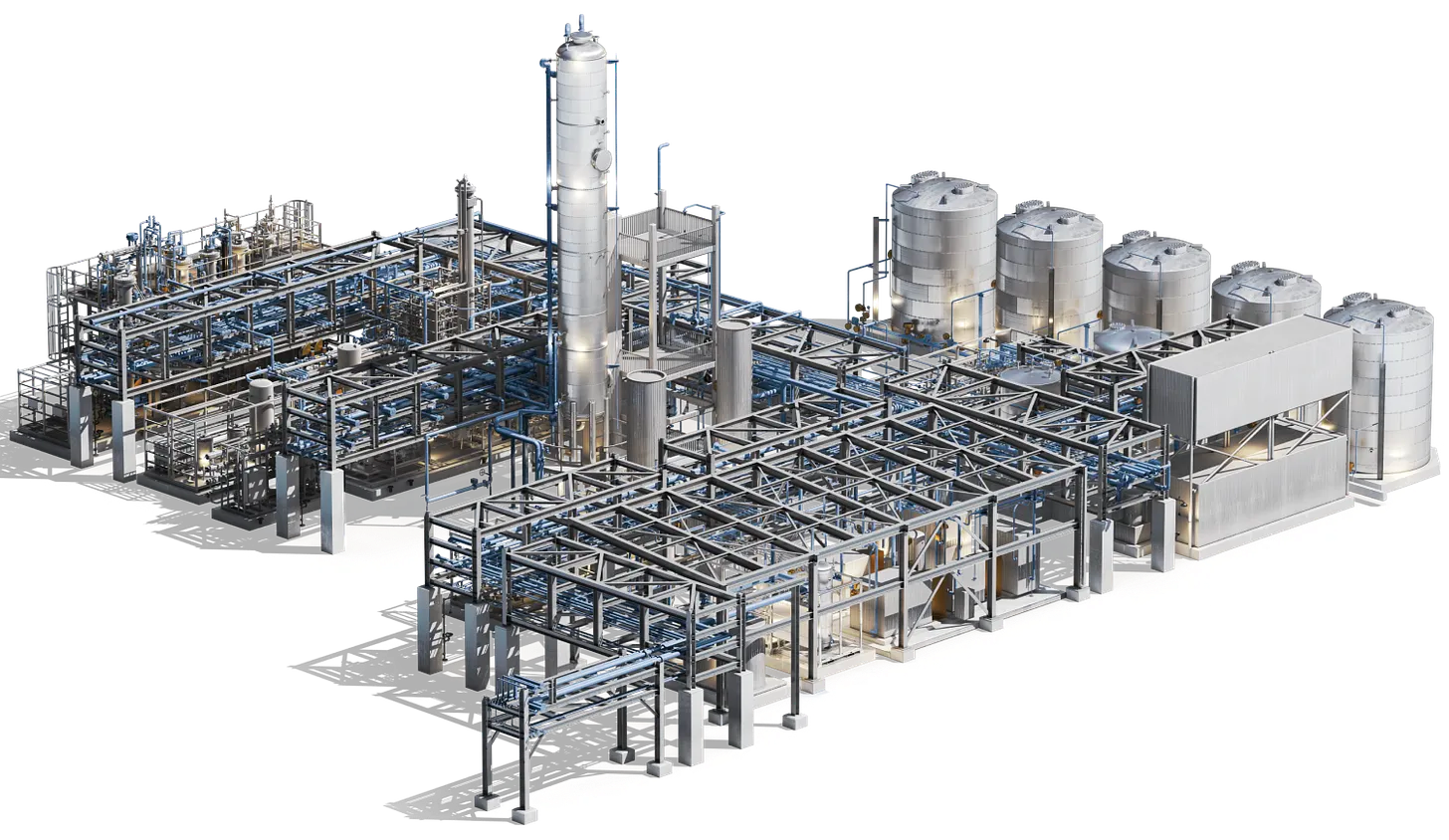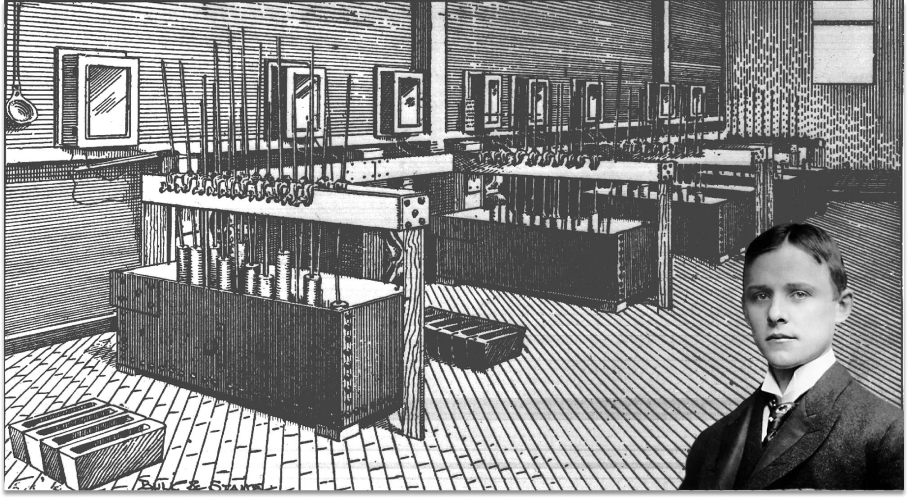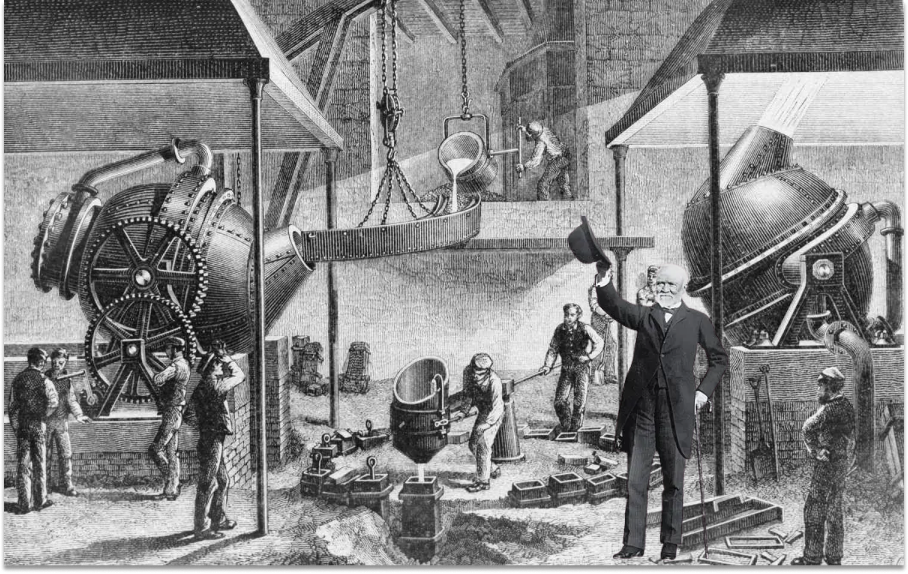Not Boring by Packy McCormick - The Techno-Industrial Revolution
Welcome to the 161 newly Not Boring people who have joined us since last week! If you haven’t subscribed, join 218,868 smart, curious folks by subscribing here: Today’s Not Boring is brought to you by… Alto With Alto, you’ve got options. Its self-directed IRA platform lets you invest in a range of alternative assets across private equity, venture capital, real assets like farmland and fine wine, cryptocurrency, private startup angel deals, and more. Better yet, investing in alts with dollars earmarked for retirement means you can make long-term and tax-advantaged decisions. Here are the top three reasons why Alto is a no-brainer:
Plus, you can now also check out the new Alto Marketplace – the premier destination for discoverability-driven securities investing. As we start off the New Year, make a good decision and learn more about Alto. (Of course, IRA rules and regulations apply, and you should seek advice from a tax professional when making investments. Alternative asset investments are inherently risky and are intended for sophisticated investors.) Hi friends 👋, I’ve become obsessed with a certain kind of company recently. This is my attempt to put a framework around the opportunity. Let’s get to it. Techno-Industrial RevolutionWe’re standing at the foot of a Techno-Industrial Revolution. Progress shifted from atoms to bits and is now shifting to a combination of atoms and bits. In Tech is Going to Get Much Bigger, I argued that cheaper energy, intelligence, and dexterity (i.e. robots), and I would add biotech and new materials to the list, will combine to increase tech’s total addressable market to include large existing industries that have been relatively untouched by technology, including industrials and agriculture. Higher margins in large industries will make for very valuable companies. These companies will look less like the tech giants of today and more like the giants of the Industrial Revolution. Some, certainly, will be the incumbents that take advantage of cheaper, more capable inputs to improve their businesses. Think Adobe incorporating AI or a factory installing robots. Cheaper, more capable inputs, in many cases, will be a rising tide that lifts all boats. Clayton Christensen would call these sustaining innovations. But I also believe that there will be a crop of new companies that challenge incumbents head-on and win, capturing large markets at high margins in the process. I’ve started calling them Techno-Industrials. Techno-Industrials use technology to build atoms-based products with structurally superior unit economics with the ultimate goal of winning on cost in large existing markets, or expanding or creating new markets where there is pent-up demand. They can leverage their structurally superior unit economics in the form of lower prices to win market share, higher gross margins, or both. Less fancily, they’ll use new technology, processes, or approaches to make physical things that customers want more cheaply than existing companies can, in a way that existing companies can’t match. Because they can manufacture more cheaply, they can either lower their prices to steal market share from incumbents or capture more gross margin. In some cases, they’ll have enough room to do both. Three examples might help explain what I mean. AndurilIn a great conversation with Patrick O’Shaughnessey, Anduril co-founder Palmer Luckey captured the spirit of Techno-Industrials as well as I’ve ever heard:
That’s exactly it: save customers money and earn high margins. That’s only possible if you figure out a fundamentally cheaper way to deliver capabilities. In Anduril’s case, that means using software to make hardware more capable. I described Anduril as a series of bets, one of which speaks to this point:
The mega-bull case for Anduril is that it’s able to capture more and more of the trillion-dollar defense market and do so at 40-50% margins instead of the 8-12% that incumbent Defense Primes lock in with cost-plus contracts. Lockheed Martin is worth $113 billion on $68 billion of revenue with 12% gross margins. If Anduril achieves a fraction of that revenue while maintaining much higher gross margins, it will be a very valuable company. SolugenSolugen is using biotech to attack the $4 trillion chemicals market. Instead of refining petrochemical feedstocks to produce chemicals, Solugen uses enzyme engineering to convert sugar and water (and eventually CO2) into chemicals. For more detail, Elliot wrote a great piece on the company after his visit to its Bioforge in Houston and Jeff Burke wrote a deep dive on the process. The takeaway is that by removing steps from the process, and using software and biology in place of traditional chemical synthesis and energy-intensive physical processes, Solugen is able to produce chemicals at a higher yield, lower environmental footprint, lower cost, and higher margins than incumbents. Solugen bills itself as a climate friendly company – its homepage announces “We decarbonize the physical world” – but as Elliot writes, “The climate benefits have a tertiary impact on Solugen’s sales strategy. First, they compete on price and customer experience.” What’s illuminating is that by cutting steps out of the process and replacing expensive inputs with technology, which Solugen originally did for the climate benefits, it makes the chemicals cheaper to manufacture! It gets closer to the true cost physics – what it should cost to make given the technologies, materials, and processes intrinsically required to manufacture it – of chemical production. Higher yield, lower heat and energy requirements, no waste, cheaper product. It’s very early in Solugen’s journey, but already, the company generates more than $100 million in annual revenue from its first bioforge at “software-like margins” of around 60%, founder Gaurav Chakrabarti told Bloomberg. It believes that it can build a library of enzymes and catalysts that could produce 90% of chemicals by 2030. Monumental LabsMonumental Labs’ website pronounces: “Monumental Labs is building AI-enabled robotic stone carving factories. With them, we'll create cities with the splendor of Florence, Paris, or Beaux-Arts New York, at a fraction of the cost.” The company is much younger than Anduril and Solugen, but it’s a Techno-Industrial: using technology (“AI-enabled robotic stone carving factories”) to build atoms-based products (“cities with the splendor of Florence, Paris, or Beaux-Arts New York”) with structurally superior unit economics (“at a fraction of the cost”). In my hunt for Techno-Industrials, I talked to Monumental Labs’ founder Micah Springut the other day to understand how he’s thinking about the business. It sounded familiar. In I, Exponential, I wrote about the use of modern technology like 3D models, CNC machines, Lidar scans, and 3D printers in the construction of Barcelona’s unfinished La Sagrada Família.
Monumental wants to do something similar, at city-scale. The idea is that stone should be the cheapest material for construction, even cheaper than concrete. It has cost physics on its side: making concrete requires an energy-intensive process of heating limestone and other materials to very high temperatures (around 1400-1500°C) in a kiln to make cement, which is then mixed with water, sand, gravel, and other materials. Concrete manufacturing is responsible for roughly 8% of global greenhouse gas emissions. When you use stone, you just need to get it out of the ground. You can skip the heating and processing. The reason we don’t use stone is that working stone is so labor intensive – 70-80% of the cost is labor, not the stone itself. “Stone is a cheap material being sold like a Cadillac,” Micah told me. Monumental’s bet is that by using AI-enabled robotic stone carvers, it can turn that OpEx into CapEx and dramatically reduce the cost of stone. The company is starting at the high-end of the market with its first robot – carving busts, sculptures, and architectural ornament at high margins – but Micah believes that they’ll be able to build full buildings, structural elements and all, out of reinforced stone at scale. If they succeed, they’ll make buildings more beautiful, and cheaper. Micah pointed out that we add a lot of unnecessary material to buildings – like drywall – to cover ugly reinforced rebar, for example. He thinks working with stone can simplify buildings in the same way that an electric engine is so much simpler than a piston, and lower costs in the process. Over time, if everything goes right, Monumental hopes to make a dent in the $1.5 trillion and growing building materials market, and capture margins by vertically integrating either backwards into quarries or forward into delivering turnkey building solutions. Obviously, getting everything to go just right is going to be insanely hard. It will require enormous warehouses staffed with fleets of robots, a tremendous amount of capital, an orchestra of flatbed trucks criss-crossing the country loaded with stone, selling into a fragmented and geographically far-flung market, and perhaps most dauntingly, changes to building code in the face of the concrete lobby and construction unions. Building a Techno-Industrial won’t be easy, but the prize – big margins in enormous markets – is worth the fight, and I think that cost physics is a powerful force. Aggregators and IndustrialsAnduril, Solugen, and Monumental Labs are just three examples, and all three are still relatively early in the journey. Most of the promise of Techno-Industrials as it stands lies in spreadsheets and techno-economic analyses. A skeptic would argue that we’ve heard this story before. In the 2010s, companies that dealt in the physical world promised better margins through technology. Companies like WeWork, Bird, and my company, Breather, failed to live up to that promise. Ultimately, while they were tech-enabled, the technology wasn’t infused into the product in such a way that they changed the cost physics of their industries. From an economic perspective, it was like squeezing a money balloon: we just shifted dollars from one side to the other. There are also a number of successes. DoorDash is worth $42 billion. Airbnb is worth $89 billion. Uber is worth $134 billion. I would argue that these companies didn’t change the cost physics of their industries, either. Food is not cheaper. Travel is not cheaper. Catching a ride is not cheaper. These companies are examples of what Ben Thompson famously calls Aggregators. Aggregators “aggregate modularized suppliers — which they often don’t pay for — to consumers/users with whom they have an exclusive relationship at scale.” These companies do create value. There’s value in convenience, and there’s value in being able to monetize an underutilized resource, whether that’s an empty house or an hour of time. But they don’t structurally improve the gross margins on the products in their markets. They don’t change the cost physics. Like the balloon squeezer, they just move them from one place to another. One of the key ideas behind Aggregation Theory is Clayton Christensen’s Law of Conservation of Attractive Profits. Note the word conservation. Aggregators didn’t expand industries’ profits as much as they moved them from one place to another. Reasoning about Techno-Industrials requires us to go back further in time, all the way back to the Industrial Revolution in America. I’m calling this coming stage the Techno-Industrial Revolution, but the Industrial Revolution was a techno-industrial revolution, too. Companies like ALCOA and Carnegie Steel invented or leveraged new technology to atoms-based products with structurally superior unit economics with the ultimate goal of winning on cost in large existing markets, or expanding or creating new markets where there is pent-up demand. Take ALCOA. In 1880, before Charles Martin Hall and Paul Héroult independently invented what became known as the Hall-Héroult Process for aluminum smelting, the metal sold for $17 per pound. In 1884, the US only produced 125 pounds of aluminum, at least 100 ounces of which went to the capstone of the newly built Washington Monument, the tallest structure in the world. In 1903, the Wright Brothers built the engine for their historic plane using aluminum alloy. By 1930, aluminum sold for $0.20 per pound and ALCOA was responsible for over half of worldwide aluminum capacity. The US alone produced 148,000 tons of the metal in 1939. When Sputnik launched in 1957, it brought its aluminum body into orbit. Today, it’s impossible to imagine the world without the lightweight, flexible metal and its alloys. ALCOA dominated the industry so handily that in 1938, FDR’s Justice Department sued it for antitrust based not on rapacious practices, but on market share alone. Hall invented a technology (and protected it with patents) to manufacture a product with structurally superior unit economics in order to bring down costs and both successfully compete in existing markets and create new ones. Or take Carnegie Steel. In 1860, when Andrew Carnegie was dabbling in iron investments, the superior steel was so expensive to make that it was only made in small batches; the US produced only 13,000 tons that year. But in 1872, Carnegie saw the Bessemer Process in action at a plant in England, and introduced it to his J. Edgar Thompson Steelworks in 1875. By the turn of the century, the US produced over 11 million tons of steel, and Carnegie was its largest and most profitable producer. The first ton of steel Carnegie produced cost about $56; by 1900, Carnegie was producing steel at $11.50 per ton, a 72% decline. At lower prices and increased manufacturing capacity, steel underpinned railroads, ships, and newly-possible-thanks-to-steel skyscrapers, which helped meet the growing demand for urban dwellings to house an influx of immigrants. The 1901 sale of Carnegie Steel to JP Morgan’s U.S. Steel for $480 million made Carnegie the richest man in the world and gave the newly-created conglomerate two-thirds of the US Steel market. Carnegie used a new technology, and vertically integrated around it, to manufacture a product with structurally superior unit economics in order to bring down costs and both successfully compete in existing markets and create new ones. ALCOA and Carnegie Steel took two different approaches – innovation and integration, respectively – to achieve the same ends: driving down costs and increasing production. As Carnegie himself put it:
By structurally superior unit economics, I mean that there is something in the way the product is manufactured or delivered that gives the Techno-Industrial a cost advantage that can’t easily be replicated. For ALCOA, that was the patented Hall-Héroult Process. For Carnegie Steel, it was the application of the new Bessemer Process combined with vertical integration of the supply chain and a maniacal focus on cost across the whole thing. In both cases, new technology was a necessary ingredient that the companies leveraged in their manufacturing processes in order to drive down costs, grow demand, and increase scale to drive costs down further. They didn’t just change prices, they got closer to the true cost physics of their products. Modern Techno-Industrials can take either the ALCOA inventor route or the Carnegie integrator route. I’d argue that Solugen is an example of an inventor and Anduril and Monumental Labs are integrators, although the line, in both the old examples and the new, is a little blurry. In either case, they will face enormous headwinds as they race to scale. Techno-Industrial ChallengesOperating in the world of atoms is different than operating in the world of bits. In the world of bits, you don’t need to ask permission; in the world of atoms, you do. In bits, you can pivot and iterate and ship updates and run experiments; in atoms, you need to have your strategy and roadmap dialed in early. In bits, you can build early products with very little capital, and increasingly, you can scale with less capital; in atoms, you need large pools of capital, including venture capital, but also including debt, asset-based financing, and project financing. As energy, intelligence, and dexterity get cheaper, the world of atoms will come to look more like the world of bits, but it will never be as fluid as the world of bits. There are a few big categories of challenges that Techno-Industrials will need to face that software companies don’t. The first is that manufacturing is hard. I didn’t listen to the whole Elon Musk Joe Rogan interview, but in the bit that I heard, Elon mentioned how hard manufacturing is roughly 100 times. Getting something to work in the lab is very different than getting it to work at scale. Making one of something at whatever cost is very different than repeatedly making thousands of that thing at a cost that looks anything like the cost in a techno-economic analysis. The incumbents that Techno-Industrials will be competing with are excellent at manufacturing. It’s what they do. The chemical giants like BASF and Dow are manufacturing wonders. The concrete industry produces billions of cubic meters of the product every year. Relatedly, incumbents have scale and distribution. They have long-standing supplier and customer relationships around the world. In many cases, these battles will be a race to see if incumbents can get technology before Techno-Industrials get scale and distribution. In some cases, Techno-Industrials (the inventors) might be protected by patents, but large companies might find it economically advantageous to ignore the patents and bleed poorer startups dry in court. And if not in America, Chinese manufacturers will certainly run roughshod over intellectual property and flood the market with cheaper versions of the same product. Competing in markets in which Chinese companies are unable to serve western customers is a key consideration. Within America, regulations can either be helpful or harmful. Regulatory capture by incumbents is a real threat to Techno-Industrials. Lobbying efforts come up in every conversation with Techno-Industrial founders. Anduril famously hired more lobbyists than engineers in its first few months. Watch the Bill Gurley talk again for a sober reminder. Then, there’s the matter of timing. These are such big and exciting opportunities that companies will attack them whether or not the economics make sense quite yet, in hopes that they will when the time is right. There’s a graveyard full of companies that were too early, and I suspect we’ll see many Techno-Industrials emerge in categories that have scarred investors but might now make sense. Finally, building a Techno-Industrial is capital intensive. These companies will need to show consistent and rapid progress against their milestones in order to raise the funding they need to survive and grow. As Varda’s Delian Asparouhov told me, “deeptech companies should begin generating revenue within three years.” There are ways to overcome these challenges, of course. Tesla and SpaceX are proof that it’s possible. That might mean starting at the high-end of the market, where margins are higher and competition is less cutthroat. It might mean starting with a novel product with a smaller market that incumbents can’t or won’t build before scaling up into direct competition. It might mean positioning as a climate company in order to get customer buy-in and government subsidies before translating the efficiencies that come with climate-consciousness into efficiencies that lock-in higher margins. But have no doubt, it will be a battle. I think the prize is worth it. Searching for Techno-IndustrialsThe category alternately called hard tech / deep tech / frontier tech / atoms-based / American Dynamism is on fire. The things that these companies are able to do and build boggle the mind. It takes a new, old way of thinking about tech companies to understand which might break through to become very large standable businesses, and this is my first entry in what I suspect will be an ongoing attempt to put a framework around it. While software has been all about swamping upfront fixed costs with high gross margins as revenue grows, I think the defining characteristic of successful Techno-Industrials will be whether they have a structural cost advantage. That might come from an in-house invention or the integration of a number of new capabilities in novel and defensible ways. In either case, if Techno-Industrials are to succeed, it will be because they leverage technology to do what technology is supposed to do: give people more and better for less. We covered three examples – Anduril, Solugen, and Monumental Labs – taking three different approaches towards that end. Beautifully, there is no playbook written yet, and I suspect each Techno-Industrial will forge a different path. I’m on the hunt for more examples – please send me your favorites – both to analyze and potentially to invest in. While the challenges they face will be enormous, the potential equals it. For the first time in a long time, tech companies have the opportunity to rebuild the world’s industrial base and tap into huge, existing pools of revenue at higher margins than incumbents can. Assuming the same revenue – a safe assumption, since revenue will likely grow with lower prices – structurally higher margins will create more valuable companies than the incumbent comps. I suspect that in a decade or two, there will be dozens of trillion-dollar companies, and my bet is that many of them will be Techno-Industrials. Thanks to Dan for editing! That’s all for today. We’ll be back in your inbox with a Weekly Dose on Friday. Thanks for reading, Packy |
Older messages
Weekly Dose of Optimism #77
Friday, January 19, 2024
Melei, Ultrasound, Micro-supercolliders, Optimus Folds, Alpha Geometry
The Experimentation Layer
Tuesday, January 16, 2024
You need to f*** around to find out.
Weekly Dose of Optimism #76
Friday, January 12, 2024
Figure, Rabbit, Emissions Decline, Blood-Brain Barrier, RetroPFG
Pace Yourself
Friday, January 12, 2024
Kicking the Year Off with Pace Layering
Weekly Dose of Optimism #75
Friday, January 5, 2024
ALOHA, LNG, Weight-Loss Capsules, Meissner Effect?, AVC Predictions, Choose Optimism.
You Might Also Like
🔮 $320B investments by Meta, Amazon, & Google!
Friday, February 14, 2025
🧠 AI is exploding already!
✍🏼 Why founders are using Playbookz
Friday, February 14, 2025
Busy founders are using Playbookz build ultra profitable personal brands
Is AI going to help or hurt your SEO?
Friday, February 14, 2025
Everyone is talking about how AI is changing SEO, but what you should be asking is how you can change your SEO game with AI. Join me and my team on Tuesday, February 18, for a live webinar where we
Our marketing playbook revealed
Friday, February 14, 2025
Today's Guide to the Marketing Jungle from Social Media Examiner... Presented by social-media-marketing-world-logo It's National Cribbage Day, Reader... Don't get skunked! In today's
Connect one-on-one with programmatic marketing leaders
Friday, February 14, 2025
Enhanced networking at Digiday events
Outsmart Your SaaS Competitors with These SEO Strategies 🚀
Friday, February 14, 2025
SEO Tip #76
Temu and Shein's Dominance Is Over [Roundup]
Friday, February 14, 2025
Hey Reader, Is the removal of the de minimis threshold a win for e-commerce sellers? With Chinese marketplaces like Shein and Temu taking advantage of this threshold, does the removal mean consumers
"Agencies are dying."
Friday, February 14, 2025
What this means for your agency and how to navigate the shift ͏ ͏ ͏ ͏ ͏ ͏ ͏ ͏ ͏ ͏ ͏ ͏ ͏ ͏ ͏ ͏ ͏ ͏ ͏ ͏ ͏ ͏ ͏ ͏ ͏ ͏ ͏ ͏ ͏ ͏ ͏ ͏ ͏ ͏ ͏ ͏ ͏ ͏ ͏ ͏ ͏ ͏ ͏ ͏ ͏ ͏
Is GEO replacing SEO?
Friday, February 14, 2025
Generative Engine Optimization (GEO) is here, and Search Engine Optimization (SEO) is under threat. But what is GEO? What does it involve? And what is in store for businesses that rely on SEO to drive
🌁#87: Why DeepResearch Should Be Your New Hire
Friday, February 14, 2025
– this new agent from OpenAI is mind blowing and – I can't believe I say that – worth $200/month








